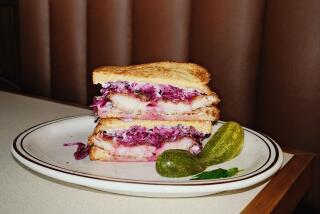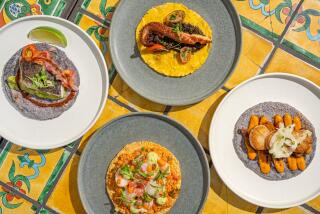Los Angeles chefs are happy to be in a pickle
Pickles might be scarcer in contemporary home kitchens than they were a century ago, but scan a brasserie menu, or order a bar special at a gastropub or a charcuterie plate at an urban steakhouse, and everywhere: pickles.
The walk-in refrigerator at the Hollywood restaurant Ammo looks like a pickle museum. There are tubs of fennel and haricots verts (thin French beans); buckets of shiitakes, Weiser Family Farms cantaloupe and watermelon rinds; all the pretty fruit and vegetables submerged in brines. As new executive chef Julia Wolfson stacks more containers -- ramps (wild leeks) in vinegar with green cardamom pods, Bing cherries pickling in balsamic vinegar spiced with whole star anise -- she seems more like a country kitchen pioneer than a young chef newly at the helm of a chic L.A. restaurant.
“I love to pickle,” Wolfson says, surveying the 14 containers of pickled produce. “It’s a really fun technique that adds brightness to my food -- and there’s so much you can do with it.”
Wolfson has a nine-vegetable pickle plate on her menu. She pairs braised pork ribs with pickled Santa Rosa plums, or steak tartare with pickled rhubarb. Pickled red onions punctuate a tomato-corn-cilantro salad with house-made duck confit. The dressing? A splash of extra virgin olive oil, Maldon sea salt -- and the pickling liquid. “It’s like an instant vinaigrette,” Wolfson says.
At Charlie Palmer at Bloomingdale’s in Costa Mesa’s South Coast Plaza, executive chef Amar Santana has almost as many vats of pickles as Wolfson does. On a recent afternoon, a kitchen prep table is lined with tubs of house-made sauerkraut, pickled ramps, preserved lemons in brine, pickled cherries and pearl onions.
“The sommelier hates me,” says Santana, a native of the Dominican Republic, who’s spent seven years with Charlie Palmer, most recently at his New York restaurant Aureole. “They can never pair wines with [pickled items]. When I was in New York, I’d buy Mason jars and pickle everything.”
Up the escalators at Marché Moderne, chef-owner Florent Marneau says he learned pickling techniques from his mother in France, where the family had a large garden. “We had to come back home from vacations because of the cornichons, they’d grow so fast,” says Marneau, who pickles breakfast radishes and black radishes, cauliflower, English cucumbers and, in their short season, ramps. “I’ll put pickles on the charcuterie board, with a veal tongue salad,” Marneau says. “I made veal head cheese last night -- I’ll put them with that.”
At the Corona del Mar gastropub the Crow Bar and Kitchen, chef-partner Scott Brandon offers a pot of pickles on his bar menu. Recently the pretty ceramic pots have been loaded with pickled asparagus, green beans, pearl onions, Weiser Family Farms multicolored baby carrots, and cucumbers. (The asparagus and beans also go into Bloody Marys; the onions grace Gibsons.) Brandon pickles what’s in season, using “whatever cool stuff happens to be available.”
Chef-owner Ben Ford of Ford’s Filling Station in Culver City pickles fennel, carrots, beets, even Fresno chiles. “Pickled peppers go on the Serrano [ham] flatbread,” he says. “The octopus salad has pickled peppers and pickled fennel.” (Try saying that five times fast.)
How it’s done
WHILE home cooks might use a pickle press or a box of salt or might put up a batch of pickles in the summer, restaurant chefs take a more systematic -- and large-scale -- approach.
“I cut all the vegetables to the same size,” says BLT Steak’s chef de cuisine Noah Rosen, who serves a lovely pickle plate with his charcuterie tray VIP amuse. Rosen blanches haricots verts, then adds them to raw vegetables, which might include English cucumbers, black radishes, bell peppers, fennel and carrots.
He then pours a hot brine of cider vinegar spiced with black peppercorns, coriander and thyme over the vegetables “in a big Lexan [a clear polycarbonate container], weighted down with a plate and a can,” then parks the container in the restaurant walk-in for at least 24 hours before serving.
Most chefs tend to use this method, with variations in spicing and vegetable combinations. Ammo’s Wolfson might use balsamic, raspberry, sherry or apple cider vinegar; spicing might include bay leaves or star anise, curry or cinnamon, depending on the vegetable or fruit.
Marneau doesn’t blanch vegetables before pickling them. “You have to fight the water,” he says. “I like to have [my pickles] crunchy, more vinegary.”
Charlie Palmer chef Santana blanches his beans, but cooks the jalapeños in the pickling liquid. “I use white balsamic; you get everything, you don’t need sugar.”
Pickling is as old school as the patés and prosciutto that often accompany its results. It’s a technique born of pre-refrigeration necessity and the cyclical pattern of gardens. Of course, with their restaurant-grade refrigerators, modern chefs pickle for aesthetics as much as for reasons of kitchen logistics.
So chefs are pickling their pretty, practical pecks of peppers -- and ramps, Santa Rosa plums, Bing cherries and Romesco cauliflower -- aplenty. Yeah, yeah: Say that one five times fast too. Silently. While you wait for your appetizers.
More to Read
Sign up for Essential California
The most important California stories and recommendations in your inbox every morning.
You may occasionally receive promotional content from the Los Angeles Times.











